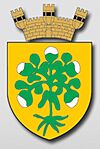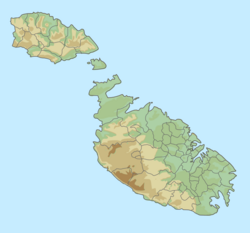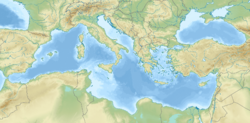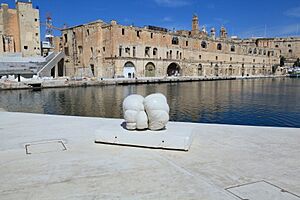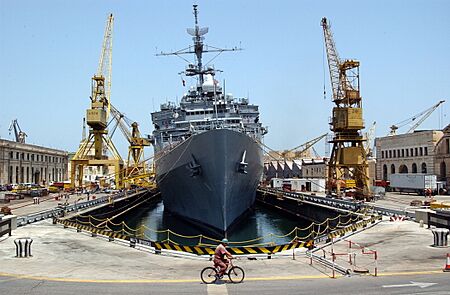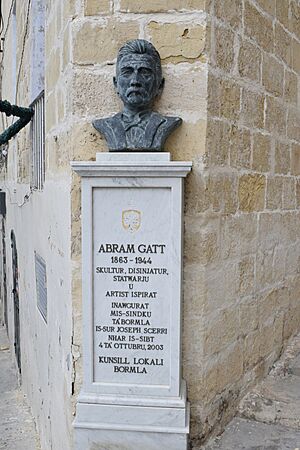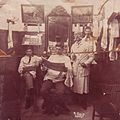Cospicua facts for kids
Quick facts for kids
Cospicua
Bormla
Maleth
Bir Mula, Burmola, Bormola Città Cospicua, Città Cottonera |
|||
|---|---|---|---|
|
Local council
|
|||

Bormla as seen from Dock No. 1
|
|||
|
|||
| Nickname(s):
Belt l-Immakulata
|
|||
| Motto(s):
Ingens Amplectitur Agger
(Embraced by a large bastion) |
|||
| Country | |||
| Region | Port Region | ||
| District | Southern Harbour District | ||
| Borders | Birgu, Fgura, Kalkara, Paola, Senglea, Żabbar | ||
| Area | |||
| • Total | 0.9 km2 (0.3 sq mi) | ||
| Population
(Jan. 2019)
|
|||
| • Total | 5,170 | ||
| • Density | 5,700/km2 (14,900/sq mi) | ||
| Demonym(s) | Bormliż (m), Bormliża (f), Bormliżi (pl) | ||
| Time zone | UTC+1 (CET) | ||
| • Summer (DST) | UTC+2 (CEST) | ||
| Postal code |
BML
|
||
| Dialing code | 356 | ||
| ISO 3166 code | MT-06 | ||
| Patron saint | Immaculate Conception or the Virgin Mary | ||
| Day of festa | 8 December | ||
Cospicua (also called Bormla in Maltese) is a historic city in Malta. It's a harbour city with strong walls, located in the Port Region. Cospicua is one of the famous Three Cities found within the Grand Harbour, right next to the capital city, Valletta.
Long ago, it was known as Maleth and was an important port for the Phoenicians. Some people think the name of the island and country of Malta might even come from this old name! Cospicua is a busy place, and its people are known for their special way of speaking, called the Cottonera dialect.
Cospicua: A Historic Maltese City
What's in a Name?
The ancient Phoenician name Maleth meant "refuge" or "port". This is similar to the Hebrew word malat, which means "escape". The Greek name Melítē and Latin name Melita likely came from this old name. These names were later used for the island of Malta itself.
The Maltese name Bormla probably comes from a mix of Arabic and the old Phoenician name. Some stories say it means "well of the landlord" or "well of the Lord".
Cospicua's Long History
Cospicua has been a home for people since Neolithic times, which was thousands of years ago! The Phoenicians set up a colony here called Maleth around the 10th century BC. It was an important port for them.
From Ancient Times to Knights
When the Order of Saint John arrived in Malta, the city was known as Bormla. The Knights started building strong walls around Bormla in 1638. These walls were built to protect the city and its neighbours, Birgu and Senglea. It took about 70 years to finish these impressive fortifications. In 1722, a leader named Grand Master Marc'Antonio Zondadari officially declared Bormla a city. Because of its strong walls, he named it Città Cospicua, which means "Conspicuous City."
British Rule and the Dockyard
In 1776, the Knights of St. John began building a dockyard in Cospicua. This dockyard became very important for the city's growth. During the time when Britain ruled Malta, the Royal Navy used the dockyard a lot. It was especially busy during big conflicts like the Crimean War and the First World War. It was also very important in the years leading up to the Second World War.
During the Second World War, Cospicua and the areas around the Grand Harbour were heavily bombed. This was because Malta was under attack by the Axis powers.
Modern Times and Changes
After Malta became an independent country, the city's dockyard often caused disagreements. In the early 2000s, the dockyard was made much smaller. This was because it was very expensive to run. Today, there are plans to turn part of the dockyard into a place for businesses and tourists.
Cospicua is also known as Belt l-Immakulata, which means "City of the Immaculate." This refers to the Immaculate Conception or the Virgin Mary, who is the city's special protector. Every year, a big celebration is held on December 8th.
Fun Facts About Cospicua's Culture
Cospicua celebrates its main feast day on December 8th, honoring the Immaculate Conception. The city is also famous for its Good Friday celebrations, which started in the 18th century. Many tourists come to see these events. A statue of the Resurrection of Jesus is carried through the streets. This shows Jesus' victory over death. Smaller statues are also displayed around the city.
The people of Bormla also started the "Mejda tal-Appostli." This means "table of the Apostles." It's a display that shows the types of food eaten during the Last Supper of Jesus and his 12 Apostles. You can also see different Bible stories made with colored rice and salt on plates.
Cospicua has a football team called the St. George's F.C.. It's thought to be the oldest football team on the island! Records show that by 1885, there were already three football teams in Cospicua. They all joined together in 1890 to form the current club. Cospicua is also well-known for its Regatta team, which was one of the first. This team has won 17 titles, which is a lot!
The 1st Cospicua Scout Group was formed in 1917. The St. George's Band Club started officially in 1862. It was first called 'La Banda dei Cospicuani'. Later, its name changed to the current one when Giorgio Crispo Barbaro became its first president.
Amazing Buildings in Cospicua
The city's strong walls, called the Santa Margherita Lines and the Cottonera Lines, are mostly still standing. They need some repairs, but they are very impressive. Saint Helen's Gate, also known as Vilhena Gate, is a famous entrance that is part of the Santa Margherita Lines. It's a popular spot for visitors. The Dock area also has some beautiful buildings from the Georgian era.
Other important buildings include the Parish Church of the Immaculate Conception, the church of St. Theresa, and the chapels of St. Paul and St. Margaret. The celebrations on Good Friday, Easter Sunday, and the village feast on December 8th also bring many visitors. People come to see the statues of the Resurrection and the Immaculate Conception.
Cospicua also has a special place called Bir Mula Heritage. It's a museum that teaches about the city's history, culture, and people. There's also a 16th-century building called The Lodge, built by the Order of St John. It's used for art shows and other events. Next to The Lodge is another old building from the 16th century. It's home to a local radio station called Kottoner 98FM.
How Many People Live Here?
The first official count of people in Malta was in 1901. Cospicua had 12,148 people then. This number stayed about the same until 1931. But by 1948, the population had dropped to 4,822. It went up again to over 9,000 in the 1950s and 60s. After that, the population slowly decreased. In March 2014, about 5,395 people lived in Cospicua.
Famous People from Cospicua
Many notable people have come from Cospicua, including:
- Karmenu Mifsud Bonnici – a former Prime Minister of Malta.
- Ugo Mifsud Bonnici – a former Minister and also a former President of Malta.
- Anton B. Dougall – a Maltese chef, writer, and TV personality.
- Dom Mintoff – another former Prime Minister of Malta.
- Erin Serracino Inglott – a linguist and author. A school in the city is named after him.
- Abram Gatt – a talented sculptor.
- Gianni Vella – a famous artist.
- Paolino Vassallo – a well-known composer.
Exploring Cospicua's Areas
Here are some of the interesting places and areas within Cospicua:
- Dock No. 1
- Fortini ta' Feliċ
- Kortina San Nikola
- San Ġwann t'Għuxa
- Fuq San Pawl
- Fuq Santa Margerita
- Fuq Verdala
- Ta' Santa Liena
- Tal-Foss
- Xatt ta' Bormla
- Ix-Xgħajra ta' Bormla
The area called Tal-Ħawli used to be part of Bormla. However, since 1994, it has been managed by the Birgu Local Council.
Images for kids
-
Cospicua in 1846. Photo by Calvert Jones.
-
Cospicua in 1846. Photo by Calvert Jones.
-
Cannavò barber shop on Cospicua's waterfront, 1910s, by Richard Ellis.
See also
 In Spanish: Bormla para niños
In Spanish: Bormla para niños



